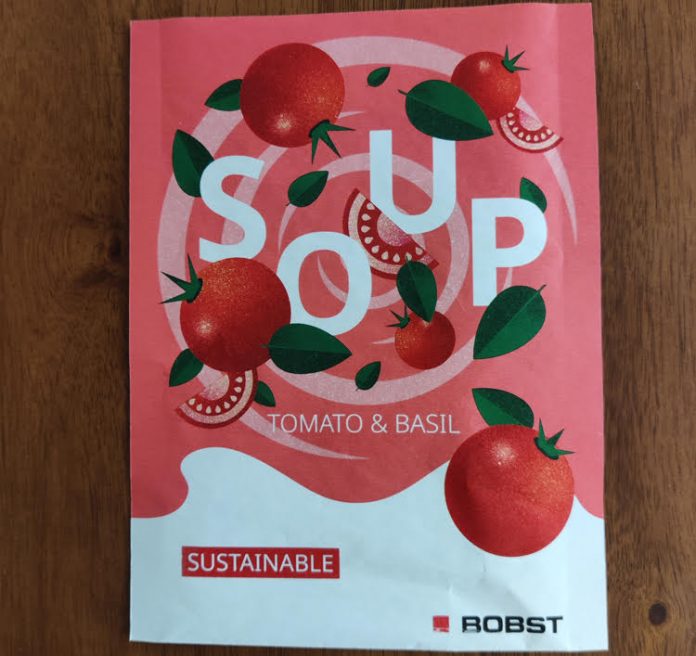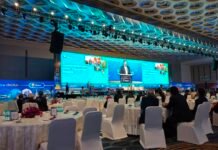
Developed jointly by Bobst, Michelman, and UPM, Priyanka Tanwar attempts to get inputs on oneBarrier FibreCycle and sustainable packaging from Shailesh Nema, vice-president and managing director of Michelman India in Mumbai; Nilesh Pinto Zone Business director at Bobst in Mumbai, and Sarah Alexander MarCom manager Flexible Packaging Industry at Bobst in Europe. While Alexander speaks about the technical prospects of the oneBarrier solution, Nema and Pinto speak about the Indian situation, the opportunities for innovation, and the need to improve regulations and compliance with the plastic waste management regime.
PSA – Please tell us about the Bobst-Michelman-UPM collaboration – the oneBarrier FibreCycle solution for food packaging.
Sarah Alexander – Bobst, Michelman, and UPM teamed a couple of years ago with one common target, which was to find a recycle-ready full-paper solution as a high-barrier alternative to the non-recyclable flexible packaging solutions on today’s market. Each partner brings its area of expertise and its innovations. For more information on this please see the article on our website
PSA – What are the ways forward to implement FibreCycle in India, what are the assets that are needed?
Sarah Alexander – FiberCycle is an example of just one of these barrier solutions and it utilizes the synergies between wet dispersion coating and dry vacuum coating to achieve high-performance paper-based solutions with barrier performance equivalent to plastic-based flexible packaging.
From the Bobst side, we are offering the oneBarrier solution composed of a vacuum metallizer and a coater that is dedicated to the paper process. Here, we have the right technology and equipment configuration to work with the right substrates (UPM paper and Michelman primer). We are selling such equipment globally and India is certainly not off the map – we already have a very good installed base of metallizers in India.
PSA – What are the challenges in the implementation of oneBarrier FibreCycle food packaging in India?
Sarah Alexander – The challenges are not so much in the implementation of the oneBarrier FibreCycle, but in the individual country’s infrastructure for recycling. We know that Europe is further ahead than the rest of the world. We also know that some geographical areas prefer paper solutions due to the current recycling and sorting systems, such as North America for example. We know that in some cases it will be the global brands pushing and promoting one solution type rather than another (mono-material polymer-based solutions, paper-based solutions, or even biodegradable and compostable solutions with a push on home compostable packaging).
We are working on all areas together with different ecosystems of partners as we need to be ready on all fronts. We do not know which will be the most dominant, or if there will be a ‘winner.’ We do believe that we need to develop different sustainable alternatives and oneBarrier FibreCycle is one of the successes that Bobst and its partners are offering.
PSA – The single-use plastic ban came into effect in India on 1 July 2022. Please share your thoughts on this landmark step.
Nilesh Pinto –The ban aims to stop producing, importing, and selling plastics that will be used once and then find their way into the dustbin. With no proper system of collection, segregation, and reprocessing, this material will in all probability find its way to the landfills. The objective of the ban is to curtail the impact of ‘single-use plastics’ (SUPs) on the environment by lowering plastic pollution. I feel this is an opportunity and could be the driving force for new and ingenious eco-friendly substitute inventions. This step by the government will bring about more growth, awareness, and responsibility towards a better future for us and generations to come
PSA – How is the shift from plastic to paper taking place in India?
Nilesh Pinto – Surprisingly, a lot of interest is being generated among brand owners and converters towards the recent innovations showcased by Bobst through the FiberCycle. FiberCycle is an example of just one of these barrier solutions and it utilizes the synergies between wet dispersion coating and dry vacuum coating to achieve high-performance, paper-based solutions with barrier performance equivalent to plastic-based flexible packaging. At this stage, there is a lot of evaluation taking place globally and in India on what items can be considered for substitution, at what cost, the investments, and the gestation period.
PSA – Tell us how Michelman sees the innovative oneBarrier FibreCycle food packaging developed by the Bobst-Michelman-UPM collaboration.
Shailesh Nema – There is a tremendous amount of focus on sustainability. Many countries around the world are focusing on recyclability and ensuring that the waste is recycled and does not end up in the landfills. In India, with the plastic waste management regulation act, we have taken a giant leap now from 1 July 2022, wherein we are banning many plastic components that are embedded with the packaging structures here, for example, paper cups and paper plates. There is a very significant amount of penalty imposed for multi-layer plastic packaging, which is used by large FMCG companies.

The demand for sustainable products has been there for a long time and what we have done is that we have come up with a very unique coating that provides and improves oxygen barrier as well as a moisture barrier. We have collaborated with UPM so that on a particular paper of UPM, these coatings are done with technology from Bobst – the alubond technology. It can then provide the properties of an oxygen barrier as well as a moisture barrier in such a way that it can be used for large facets of food companies. It can sustain the packaging structure and can be used for many applications in the food industry.
PSA – Are you in talks with any of the food companies for the use of this coating?
Shailesh Nema – We are already in touch. When we were developing this product, we were closely coordinating with large food companies. For now, I cannot name them but it is already in use by one of the largest food companies in the world based in Europe.
PSA – What are your thoughts on the single-use plastic ban that has been imposed from 1 July?
Shailesh Nema – The Plastic Waste Management Regulation Act came in 2016 and since then, for one reason or another, we had been postponing implementation or implementing it piecemeal – and now I think the government has taken a tougher stance, considering the need to get rid of the waste mountains [at landfills] and the issue for the government in terms of non-recyclable products.
This is a hugely welcome step for us. Companies like Michelman already have solutions that are proven to ensure that we can deliver sustainable solutions and packaging structures that are compliant with PWM regulations. We have an innovation center in Mumbai wherein we are already working with multiple brand owners and converters to design packaging structures that are going to be compliant with PWM.
PSA – What are some of the sustainable solutions that Michelman offers?
Shailesh Nema – We offer solutions for paper cups, paper plates, paper balls – packaging structures for multiple food applications. We are actively working with converters and brand owners to change the multi-layer plastic structures to mono-layer or mono-family plastic structures. With the mono-structures, the recyclability aspect is taken care of because recycling a mono-structure is significantly easier than recycling a multi-layer plastic structure. We have solutions around that and we are working with multiple brand owners.
PSA – Would you like to talk about the shift to paper in Indian packaging?
Shailesh Nema – Yes. I think paper is a solution for a few applications. Obviously, paper cannot replace plastic as plastic is by far superior in terms of barrier properties to paper. But if a paper is reinforced correctly and optimally with the right barrier properties, then it can offer solutions to replace some of the applications. For example, if we have to convert to dry foods then there is a requirement of moisture barrier properties, which is higher. And then you can always attain those moisture barrier properties using, say, Michelman coatings on the paper. The packaging structure then becomes sustainable. Yes, the movement is there. The shift from plastic to paper has begun but in our opinion, it is still very slow. Once the regulation becomes more firm, I think it will speed it up.
PSA – Would you like to comment on the coatings industry in India?
Shailesh Nema – I think the coatings industry for packaging and printing in India is still in the initial stages and, as I said, it is all driven by regulation. Earlier, the regulation had been very weak but now it is firming up. Once the regulation is more in force, I think there are enough international and local suppliers in the coating industry to meet the sustainability needs of the printing and packaging industry.
PSA – Would you like to add anything else from your side?
Shailesh Nema – I would only say that this is a change that we absolutely need – changing from non-recyclable packaging structures to recyclable ones. When we speak about these changes, there are a lot of opportunities for us to help other countries in making sure they can change to a more sustainable model. In India, we have the infrastructure, we have the manpower, and yes, the change can be slow. But we all need to work in that direction. We need to ensure we are PWM-compliant. We can offer sustainable solutions in the country and export these solutions. The opportunities are there and I think we have to work together to maximize the return on that.
My message to your readers is that we don’t have a planet B and a very simple analysis or a simple statistic I would like to share is that India has four times more population than America while America has four times more geographic area than India – that means the per capita land available to each of us as compared to an American is one-sixteenth. That’s far less land available to us and we cannot make use of it by having acres and acres of landfills or waste mountains in India. We have to find a solution to that so that we can build something better for the community and, of course, reduce pollution significantly.










